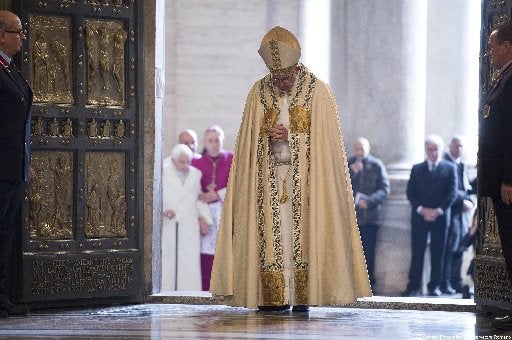Diocesan Holy Doors will not be feature of Jubilee 2025, Vatican says
VATICAN CITY (CNS) — While bishops around the world are asked to designate their cathedrals or other significant churches as special places of pilgrimage and prayer for the Holy Year 2025, the Vatican is not asking them to dedicate and open a “Holy Door” at those churches.
The Dicastery for Evangelization, which is coordinating the celebration of the Jubilee, issued a note Aug.1 praising “the pastoral and devotional motivations” of bishops who wanted to designate a local Holy Door but saying the only holy doors will be at the basilicas of St. Peter at the Vatican, St. John Lateran, St. Mary Major and St. Paul Outside the Walls in Rome and, perhaps, at a prison.
In “Spes Non Confundit” (“Hope Does Not Disappoint”), the papal bull officially proclaiming the Holy Year, Pope Francis wrote that “in order to offer prisoners a concrete sign of closeness, I would myself like to open a Holy Door in a prison, as a sign inviting prisoners to look to the future with hope and a renewed sense of confidence.”
In Catholic tradition, the Holy Door represents the passage to salvation — the path to a new and eternal life, which was opened to humanity by Jesus.
The tradition goes back more than 600 years. Pope Martin V, in 1423, opened the Holy Door in the Basilica of St. John Lateran — the cathedral of the Diocese of Rome — for the first time for a jubilee. Later, Pope Alexander VI had Holy Doors opened at the four main basilicas in Rome for the Holy Year of 1500.
The doors are formally closed at the end of a Holy Year and then bricked up by masons.
Starting in the 16th century, the ceremony to open the door in St. Peter’s Basilica included the pope reciting verses from the Psalms and striking the wall covering the Holy Door with a silver hammer three times.
The designation of a Holy Door in every diocese and at many shrines around the world was an innovation Pope Francis made for the celebration of the Extraordinary Jubilee Year of Mercy in 2015-2016.
In his bull of indiction proclaiming the Year of Mercy, Pope Francis asked the world’s bishops to open Holy Doors so that their dioceses and eparchies would be “directly involved in living out this Holy Year as an extraordinary moment of grace and spiritual renewal,” ensuring the Jubilee would be “celebrated both in Rome and in the Particular Churches as a visible sign of the Church’s universal communion.”
In its note Aug. 1, the Dicastery for Evangelization pointed out that the pope did not make such a request of bishops for the Holy Year 2025.
Instead, Pope Francis asked bishops to celebrate the solemn opening of the jubilee on Sunday, Dec. 29, and suggested that “a pilgrimage that sets out from a church chosen for the ‘collectio’ and then proceeds to the cathedral can serve to symbolize the journey of hope that, illumined by the word of God, unites all the faithful.”
The Apostolic Penitentiary, a Vatican court dealing with matters of conscience and with the granting of indulgences, issued a document in May spelling out how Catholics can receive the traditional Holy Year indulgence, which the church describes as a remission of the temporal punishment a person is due for their sins.
The document said that bishops should designate their cathedral or another church or sacred place as local sites for Holy Year pilgrims. “Bishops will take into account the needs of the faithful as well as the opportunity to reinforce the concept of pilgrimage with all its symbolic significance, so as to manifest the great need for conversion and reconciliation,” the Vatican court said.
Pope Francis will open the Holy Door of St. Peter’s Basilica Dec. 24 and at St. John Lateran Dec. 29. The Holy Door at St. Mary Major will be opened Jan. 1, he said, and at St. Paul Outside the Walls Jan. 5.
